Earth Dog - Running Dog Magazine is the oldest and largest-circulation publication on lurchers and terrier work in the United Kingdom. Edited by David Harcombe, this publication features pictures and tales of working terriers and long dogs in England, Scotland, Wales, Ireland and even the U.S, and mainland Europe. If you're looking for a gift for yourself, a trial judge, or a fellow sportsman that has taken you out into the field and taught you the ropes, an annual subscription to Earth Dog - Running Dog is the way to go! To order by credit card (Visa, MasterCard, American Express, Discover, eCheck >> click here
Tuesday, May 31, 2005
Earth Dog - Running Dog - Order Online
Earth Dog - Running Dog Magazine is the oldest and largest-circulation publication on lurchers and terrier work in the United Kingdom. Edited by David Harcombe, this publication features pictures and tales of working terriers and long dogs in England, Scotland, Wales, Ireland and even the U.S, and mainland Europe. If you're looking for a gift for yourself, a trial judge, or a fellow sportsman that has taken you out into the field and taught you the ropes, an annual subscription to Earth Dog - Running Dog is the way to go! To order by credit card (Visa, MasterCard, American Express, Discover, eCheck >> click here
Fur Bearer Wild Harvest Statistics
Top 10 U.S. Harvested Furbearers, 1998
Species and Total Number Harvested
- Raccoon 2,896,089
- Muskrat 2,183,201
- Beaver 429,249
- Nutria 398,037
- Opossum 321,651
- Mink 190,221
- Red Fox 164,487
- Coyote 159,043
- Skunk 101,911
- Gray Fox 76,666
Note: these numbers only represent trapping. For example, about 500,000 coyote a year are killed in the U.S., of which only 30% are trapped. Most of the raccoon are shipped overseas, where the fur is sheared and dyed and sold as a low-cost substitute for milk or sable. Most of the wild-caught red fox are used for trim as the pelts are rarely in as prime a shape as ranched fox. Most of the possum are by-catch; animal accidentally trapped when another species was sought (such as fox or raccoon). Ditto for skunk.
Monday, May 30, 2005
Madnesss, Politicians and Dogs
I found this very well-written piece on the web site of the National Coursing Club
“MADNESS, MADNESS – MADNESS”
by Sir Mark Prescott
How many hours did Parliament devote to debating the war in Iraq? The answer is 41 hours. How many have died since that war began? If you believe independent sources 220,000 men, women and children.
How many hours did Parliament devote to debating the war in Afghanistan? The answer is 22 hours. How many human beings have died since that war began? If you believe the same independent sources again, it is in excess of 70,000 men, women and children.
How many hours have Parliament devoted to debating “Hunting with Dogs”? Answer: 700 hours. How many hares died coursing last year (wait for it) exactly 169!
If you told the Man on the Moon that 700 hours of Parliamentary time were devoted to 169 hares and only 63 hours to killing 290,000 human beings, he would scarcely believe you.
If you then described how, after 700 hours of debate and deep consideration, the Mother of all Parliaments, incorporating presumably the finest brains in the Kingdom, had fine tuned and honed a Bill, to such an extent that it had resulted in it being legal to kill a rabbit but illegal to kill a hare, the Man on the Moon would think you were joking.
If you then explained that such an offence would incur a £5,000 fine or 6 months in prison, but that almost no politician, few policemen and certainly not a dog in the world can tell the difference between a hare and a rabbit, the Man on the Moon would surely be convinced he was the victim of an elaborate joke.
Famously a BBC newsreader, some years ago, having introduced without comment footage of a Garda policeman’s dying body, partially covered by a tarpaulin, with blood pumping down the gutter, prefaced the next news item with the words “What you are about to see now, may prove disturbing” and proceeded to show footage of the Waterloo Cup. But what really is disturbing is that probably that newsreader was right to issue a warning, for modern man is so divorced, by supermarket packaging and cellophane, from the realities of nature and animal husbandry that the sight of two dogs pursuing a hare as Nature has decreed for the last 4,000 years probably is distressing.
For modern man is totally ignorant of the fact that the hare is the only mammal in creation with complete vision behind and an 180 degree blind arc in front (and now you know why it always jinks prior to disappearing through a small hole in a hedge!) When pursued it knows exactly what it is doing, for it is perfectly adapted for pursuit, and if fit, healthy and alert it will live (only 1 in 9 hares coursed are killed), but if it is slow, ill or stupid it will die (but never be wounded). This process is called Natural Selection, the survival of the fittest, upon which, as Darwin told us, depends the survival of every species in the world.
However, the hare was not designed by Evolution to evade guns, or cars it cannot see, nor to perceive the dangers of toxic sprays. Yet modern man is happy to tolerate the annual unselective slaughter and wounding of hundreds of thousands of hares by such methods, yet balk and legislate against coursing, a selective means of control, that conserves thousands each year on coursing estates yet kills only 169 animals, and those selectively, as Evolution decrees.
It is agreed by all that a banning Bill will, in total, not result in one hare’s life being saved and, further, in the words of the Game Conservancy investigation into hare numbers, “It is only on hare coursing estates that hare numbers are on the increase against the National trend”. It is an undoubted fact that, should coursing be banned, hundreds of greyhounds from off the tracks and from the Irish coursing fields, who are too cunning or too slow to earn their place will have no second career in the English coursing field. Both the dogs and the hares will all be adversely affected by a ban.
Four independent enquiries in 40 years have found in coursing’s favour; three of the last four Directors of the League Against Cruel Sports have changed their minds on its abolition. Yet modern man persists in attempting to end Britain’s oldest field sport and with it one of our oldest sporting traditions “The Waterloo Cup”.
Ban coursing and thousands of hares currently conserved will annually be shot. Hundreds of dogs will have no future and only 169 hares will be saved.
As the Man on the Moon looks down on this scene of self inflicted destruction, he can only reflect, in those saddest of closing lines to that much loved British film “The Bridge over the River Kwai”, “Madness, madness – madness!”
Sunday, May 29, 2005
Antibiotics for Working Terriers
As luck would have it, I dicovered this morning that Lambriar pet supplies has a link to "Antibiotics for Working Terriers" at http://lambriarvet.com/Links.php Nice to see that!
Thursday, May 26, 2005
Aleutians Permanently Damaged by Fox
 .
.Bird Loss Echoes on Alaska Islands;
Study calls fox infestation an ecology threat
Doug O'Harra, Anchorage Daily News, May. 22, 2005
ANCHORAGE, Alaska - It's known as one of Alaska's worst ecological disasters: Foxes introduced into scores of Aleutian Islands through the early 20th century by fur farmers ended up eating millions of nesting seabirds.
Before the invasive predators died out or were killed off from most areas, they almost drove the Aleutian Canada goose to extinction and decimated other species throughout the 1,200-mile archipelago. advertisement
But the damage went even further, delivering more than silence to the Aleutian shore. A recent scientific study of 18 islands, nine with foxes and nine without, has revealed a previously unknown ecological link between land and sea.
Seabird poop.
Minus the seasonal drizzle of guano as nitrogen-rich fertilizer, soil on many Aleutian islands simply lost the capacity to support what had been lush grassland, explained Vernon Byrd, supervising biologist with the Alaska Maritime National Wildlife Refuge and one of the study's five authors.
What once was an ocean of beach rye and other dense growth transformed into a scruffy tundra dominated by dwarf shrubs and leafy plants.
It's as though a tall forest had been shrunk to scrubland, Byrd said recently from his office in Homer.
The study has broad implications about the danger non-indigenous species like foxes pose toward isolated island habitats like those found in the Aleutians, according to the paper, published in March in the journal Science.
By knocking out key species - foxes eating up seabirds, for example - such invasive critters can cause the food chain to unravel.
The findings also give urgency to the refuge's continuing program to eliminate foxes from a dozen islands where they don't belong, Byrd said.
Two years ago, teams of trappers worked the perimeter of Adak Island, in a $150,000 project that entailed hunting down and killing foxes one at a time.
This year, teams will focus on Tanaga and Kanaga islands. A survey found foxes burrowing on high on Tanaga's volcanic slopes, possibly subsisting on ptarmigan. Russian trappers first introduced Arctic foxes on certain Aleutian Islands in the 1700s. By the early 1800s, Native Aleut people reported that seabirds were disappearing from Atka and Attu islands.
The U.S. Fish and Wildlife Service began eradicating foxes from the Aleutian Islands in 1949, employing a variety of methods ranging from poisoning to traps. By the early 1990s, the animals had been exterminated from 17 islands and had disappeared from most others, leaving foxes still present on more than 20 Aleutian islands.
Byrd, who joined the refuge staff in the late 1960s, first noticed something was amiss as he surveyed for places to reintroduce the endangered Aleutian Canada goose.
Over time, Byrd teamed up with nationally known biologist Jim Estes. Along with three other scientists, Estes and Byrd organized the study that compared vegetation and soil nutrients from fox-infested islands with places that remained fox-free.
Among other things, they found that the dense congregations of seabirds on fox-free islands produced 63 times more guano than the meager bird populations on fox-infested shores, almost 13 ounces per square meter vs. about one-fifth of an ounce.
The soil contained much higher levels of nitrogen brought from the sea in the guano. The scientist also found greater nitrogen concentrations in the grass, leafy plants, mollusks, songbirds, insects and spiders.
Naked Hypocrisy

For a really nice piece of research-based satire, I recommend a web site entitled "maninnature.com" which has done a nice piece of work disrobing the rhetoric and exposing the hypocrisy of Pamela Anderson, one of PETA's chief "spokesmodels".
Check it out >> HERE
It turns out that every facet of Ms. Anderson's career, body and future depends on animal testing and animal products -- the hair, the fake breasts, the clothes, the lipstick, even her pathetic love life.
We hope there will a sequel featuring PETA's other "spokesmodel," Anna Nicole Smith -- America's monument to fat, bleached, drunken, stupid, Valiuum-addicted Texas excess.
Wednesday, May 25, 2005
Storm Sewer Raccoons
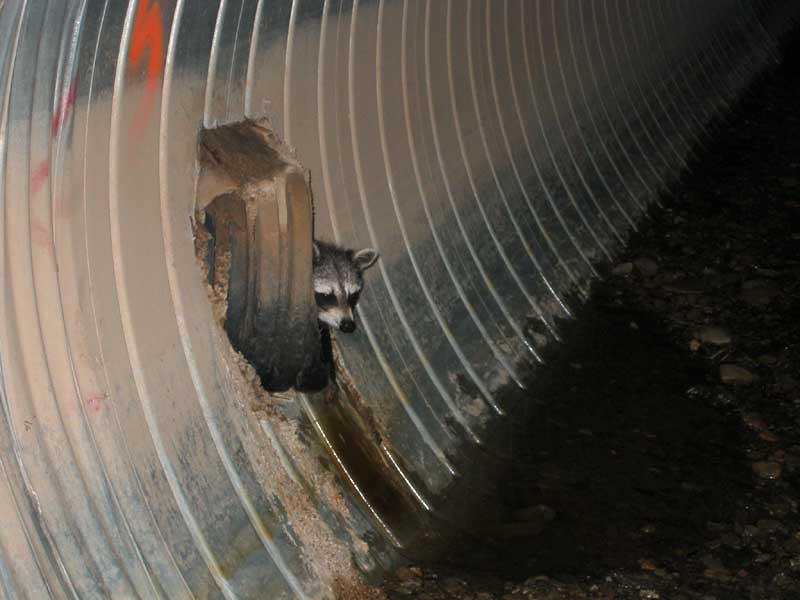
It's been over a year since I've dug on a raccoon on one of my farms -- I'm not sure what the deal is, but I suspect it's distemper sweeping through the countryside as it does every four or five years -- or perhaps it is rabies, though reports are that those numbers are down to aerial baiting.
Who knows? All I can report for sure is that while I have found some dead raccoons in the hedgerows, live ones living in groundhog holes seem to be in short supply on the farms I hunt. I am not seeing many dead on the roads either, come to think of it.
We have some urban raccoons near my house down by the river, however - they live in a few sections of the rock cliffs that rise 80 feet from the Potomac River flood plain. Nobody knows the den holes are there because you have to climb up a steep dirt and tallus slope to find them, and even then most people do not know what they are looking for -- or what they are looking at if they reach them. The holes were probably dug by groundhogs -- a few seem to be in more-or-less permanent residence on the flood plain.
The raccoons have a neat little way of getting up into the neighborhoods from the river -- they travel the storm sewer culverts which are warm in winter and cool in summer. No doubt these culverts provide their own food sources -- worms, crickets, mice, old chicken bones, etc.
If the storm pipes happen to be short on food for some reason, there are always the trash cans of suburbia and the odd dog bowl as well -- just keep going up the pipe and roll out of the storm drain right next to a trash can.
Though raccoons may not have formal calendars with the days of the week on them, I suspect they are smart enough to figure out a weekly trash schedule that never varies from one year to the next.
I have worked the raccoons down by the river a few times, but it's a risky business since the stone is quite solid and cannot be easily broken and there is not much room to stand to swing a tool. No quarry is worth risking a dog over, and I now give the river-rock-dwellers a free pass even though they are within walking distance.
Tuesday, May 24, 2005
Fox Hunting Over the Globe
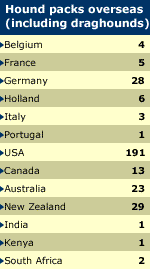
The United States has more mounted fox hunting packs than any other country except the U.K., but fox are rarely killed by U.S. mounted hunts, in part because a fox can generally find a groundhog hole to scoot into, and also because fox are simply not considered an economic problem even in sheep country. Fox are never dug out -- the hounds are praised and the field rides on to find another fox.
Coyote are another matter, and when they are hunted the goal is termination. Unlike fox, which will generally circle back and stay within a defined home territory, coyote will run straight across country and may take hounds and horses across roads and out of hunt-permission territory. Unlike fox, coyote are considered a fairly serious pest as they may, on occasion, prey on cats, small dogs, sheep, and ducks.
.
Monday, May 23, 2005
Sunday, May 22, 2005
Cast Iron Terrier Doggie Doorstop: $29
This cast iron terrier is sold by Restoration Hardward and is the hardest working terrier in the world. It's "work" is to hold open doors on breezey days.
I have a full-sized terrier bottom "going to ground" from Restoration Hardware (painted to look exactly like one of my dogs), and can vouch for the quality of the work.
This terrier is is not full-sized, but is full-bodied, and weighs in at nearly 6-1/2 lbs. Available in black or white Dimensions: 7"W x 3"D x 8"H
To order yours, go to www.restorationhardware.com or >> click here
Catalog and Web only
Saturday, May 21, 2005
Parrots Have Very Little to Say

Email lists and bulletin boards are a pretty pathetic medium for communication.
Email lists can quickly get too large and result in a lot of stupid chatter, especially where dogs are concerned. It does not take too many "Tricky Woo" pet owners to put more gravel into your "in box" than anyone wants to read.
The Bulletin Boards are at least set pieces and you can skip over sections and authors and topics. The problem with bulletin boards is that most people have nothing to say!
In the terrier world, it seems, most folks are not digging on their dogs very often, and outside of repetitive medical advice (ear mites, ring worm, round worm, superficial wound treatment, hot spots, etc), there is not all that much to tell.
What I find astounding is that so little genuine research, writing or information sharing is done on these boards. There is a breathtaking level of ignorance about canine health, wildlife, natural history, terrier history, etc. but these boards are surely not an antidote for that!
When was the last time you read something useful or interesting or new about fox, raccoon, weasel, groundhog, badger or even ducks on one of these boards? When was the last time you got a bit of practical advice about shifting rocks, closing a wound, or finding permission? When was the last time someone even wrote a well-written story about their day in the field with the dogs?
Instead, what you find on the Boards are a great number of very young or immature people who seem to get most of their attention in this world by being combative, or otherwise wanting to work out their manhood issues (and yes there are some women doing that too!).
Most of these people seem to know very little about wildlife and not too much about dogs, either.
It is ironic, but true, that in the dog world the most common animal is the parrot -- people quick to repeat what others have said or scratched out. The parrot offers no new information or expanded point of view. They have little experience of their own. Think for themselves? Go their own way? Dig their own dog?
Parrots don't do that -- they are bird-brained and can only mimic. They do not own a library card and cannot hold a shovel.
Starting a bulletin board is certainly easy nowdays, isn't it? These things are now offered up as free services, the code is easy and can be set up in an hour or two, and the only trick is to get people to keep coming back.
No committment or investment is needed. Just erect an electronic wall and let the graffitti spraying begin.
And graffitti spraying is exactly what you get about 95 percent of the time. In fact, this is the chief product of the bulletin boards -- not information but fighting, not shared experience, but name-calling.
It is like a Drunken Night at O'Malleys, except that the drunks are a thousand miles apart and hiding behind fake names.
The folks that run bulletin boards are big on "free speech," but it is pure posture to hide true poverty. The sad truth is that if civility were maintained on these bulletin boards, the real truth would come out pretty quickly -- no one has very much to say.
In the end, bulletin boards have not created a working terrier community so much as destroyed it. The pictures on "anti" web sites are all culled from bulletin boards. Educated people who might educate, motivate and represent the best of working terriers soon turn away from these boards, leaving the loud, stupid, very young, and unemployed to dominate the boards and represent us all.
It is reverse Darwinism -- a devolution to the unfit and the unsound.
I think history has shown that nothing has harmed the world of working terriers more than weakly moderated bulletin boards. Mud and slander has been slung on established breeders, 30-year diggers, working judges, and respected authors.
At times I have wondered if these things were Animal Rights honey pots -- bait stations set out to poison the working dog community. Whether intended or not, that is what most of them have become.
What a sad thing the internet has done to working terriers!
____________________
To read more on internet civility:
- Dan W. Drezner's very good post on this topic suggests that that "in the short run, provocative, vitriolic, and/or sloppy writing -- by either bloggers or commenters -- can attract attention, whereas closely reasoned analysis sometimes falls by the wayside" -- a kind of internet "Gresham's Law" in which the bad drives out the good. This would explainin why stupid topics generate more comments than intelligent ones, and why a thread full of flames is always longer than one that actually contains factual information..
- An article in The Washington Post suggests that "people often find that the way to get noticed is to trade new information, spread rumors or post more strident messages". In short, barking and biting dogs are rewarded, which is why there are so many barking and biting dogs on the boards and on the lists.
- Civility and Synchronicity on the internet is an academic paper that focuses on political discourse which notes that "in cyberspace uncivil behavior and ad hominem attacks are widespread in political discussions" and that "flaming seems to be a more salient group norm in the online political context as compared to other forms of communication online." The authors note that "only 38% of flames contained verifiable information, while over 61% of non-flames provided information." In short the rude people tend to be ignorant and fact-free or, as the authors put it, "incivility may be used to mask a lack of factual knowledge."
Tuesday, May 17, 2005
Beltway Coyotes

Coyotes Take to City Living
Encounters With Humans -- and Their Pets -- on the Rise
By David Cho, Washington Post Staff Writer
July 2, 2004
______________
Don't let the cat out. The wily coyote is making himself at home inside the Beltway.
Once a marquee image of the American Southwest, coyotes are no longer strangers to these urban parts. Their numbers are on the rise in every jurisdiction of Virginia and Maryland, and they have most recently been spotted in Falls Church, state and local wildlife biologists say.
While they have yet to move into the District, the long-snouted, furry-tailed creatures have been sighted as close as Arlington County and Silver Spring. Laura Illige, chief ranger of Rock Creek Park, said that "it's only a matter of time" before coyotes will be seen howling with Washington's famed monuments as a backdrop.
In Falls Church, where several pets have been attacked, city animal control officer Rebecca Keenan is advising residents not to allow cats or small dogs to roam, especially at night.
At the West Falls Church Metro station, a Lhasa apso was set upon by a coyote as the dog was being walked by its owner Monday night. The man was able to protect the dog by throwing rocks at the coyote to scare it off, Keenan said.
Nearby, a cat was killed in front of its owner in late May by a pair of coyotes. The woman screamed and thought she had scared them off, but they circled around the house and went after her other two cats in the back yard. She was able to get those pets inside.
Since then, the city's animal control office has received reports of coyote sightings almost every day, Keenan said.

The population growth of the coyote, an animal Native Americans call the Trickster, will likely force humans to adapt to the presence of the animals rather than the other way around, local and state officials say.
"We feel like citizens should be aware that they are here to stay," Keenan said. "We have extraordinarily diverse wildlife in this area. You'd be surprised at what's running around."
Bill Brew, who lives on the border of Falls Church and Arlington, said he was brushing his teeth in his downstairs bathroom one morning last week when he saw a pair trot right up to the window.
"One was 10 feet away looking in the window right at me, and I was thinking, 'Hello,' " he said. "They looked like a couple of scrawny dogs."
People are rarely the targets of coyotes, although rabid coyotes will attack. They usually contract rabies from hunting infected raccoons and bats. The only known human assault in Virginia in the past five years was in New Kent County in January 2003. In that case, a man riding a lawn mower was attacked by a rabid coyote weighing about 50 pounds, large for a coyote. After kicking it away several times, the man was able to get his shotgun and shoot the animal as it chased him to his front porch, state records say.
State wildlife biologists say the coyotes in the Washington region are nearly twice the size of their cousins in the Southwest and can run up to 35 mph. Virtually nonexistent in this area 20 years ago, they already seem to be losing their fear of humans.
"It does appear the have adpated to urban environnments." Dan Lovelace, a Virginia wildlife biologist. He added that residents should be careful not to leave pet food outside and should be sure to secure garbage can lids "to prevent that acclimation to humans."
Coyotes possess a wealth of hunting skills. They look like wolves, are much stronger than foxes and can silently sneak up on their prey and then pounce, like a cat. Wildlife biologists say they are highly adaptable and can eat up to 100 kinds of food, including insects, pets, grass, fruits and even shoe leather.
Some local residents view them as vermin and are calling for their eradication. That, though, might be impossible, Keenan said. Coyotes are too smart for leg traps, and it would hardly be safe to allow hunters to shoot them in city streets, she said.
"It would be like saying you need to get rid of all the raccoons in the area," she said. "I mean, how do you do that? It's hard."
Sunday, May 15, 2005
A Terrible Beauty: The Ugly Side of Show Dogs
 .
.It would be nice if I could report to you that everything is different at the AKC, and that the Time magazine article, below, is some sort of historical anachronism, but it's not.
The AKC is still in their big building in downtown New York City (260 Madsion Avenue), working tests for working dogs are still not allowed as a requirement for a championship, the AKC is still registering pet store puppies, and genetic tests for soundness -- even in deeply messed up breeds -- is still not required. The AKC still registers entire litters of dogs, and there are still no limits on in-breeding.
The only major change, as far as terriers are concerned, is that Jack Russells have been pulled into the AKC fold under the name of "Parson Russell Terrier." Go to the AKC "Parson" Russell web site and not a single mention is made of working the dogs.
The first thing the Pasron Russell breed club did was set a size standard that excluded nearly half the working dogs in America. They then dictated an ideal size for a dog that guaranteed that within a decade most "Parson" Jack Russell Terriers will be too big to work (exactly what they did with the Fox Terrier 100 years earlier). And, of course, they closed the registry, guaranteeing that in time, and with popular sire selection, the genetic pool would get narrower and inbreeding coefficients would soar.
Once again, we find an AKC breed Club dominated by people who are more interested in chasing rosettes and breeding (and selling) puppies than in preserving the characteristics of the breed they profess to admire.
Whatever the AKC is about, it is certainly not about dogs!
_________________
Time Magazine, December 12, 1994,
A TERRIBLE BEAUTY
An obsessive focus on show-ring looks is crippling, sometimes fatally, America's purebred dogs
Cover Story by Michael D. Lemonick with Ann Blackman/Washington, Dan Cray/Los Angeles and Wendy Cole/Chicago
_______________________
Four years ago, Amanda and Bob Metzger of Exton, Pennsylvania, saw an ad for golden retriever puppies in the local newspaper and went to have a look. "Once we saw them," says Amanda, "we fell in love. We couldn't have left the place without one." They decided on a dog they named Jake -- but being careful consumers, the Metzgers made sure the breeders had a solid reputation, insisted on an American Kennel Club certification of Jake's pedigree and got assurances that his parents were free of health problems before they handed over $ 325 for their dog.
Their troubles started three months later. Jake began to limp on his left front leg; the vet diagnosed osteochondritis, an inherited bone condition, and had to operate. The bill came to $ 650. Six months later, Jake went lame again, and X rays showed severe dysplasia, a hereditary weakness of the joints, in both hips. A $ 750 operation relieved his pain, but even with a dose of aspirin almost daily, Jake still walks stiffly. On top of that, he has severe allergies, dry skin and a poor coat. He has recently started having seizures as well. "He's a medical mess," says Amanda Metzger. "It just breaks my heart because he wants to play like a puppy, but he can't."
It would be tempting to put Jake's problems down to plain bad luck -- but in fact the odds were against him from the start. While most golden retrievers are healthier than Jake, a shocking 60% of them end up with the dysplasia that may yet cripple him, according to the University of Pennsylvania's School of Veterinary Medicine. Many are born with an undescended testicle, another hereditary condition vets say can cause the gland to become cancerous.
Yet even if they had chosen another breed, the Metzgers would have been taking a chance. The appalling truth is that as many as 25% of the 20 million purebred dogs in America -- 1 in 4 animals -- are afflicted with a serious genetic problem. German shepherds, for example, run an even higher risk of hip dysplasia than do golden retrievers. Labrador retrievers are prone to dwarfing. At least 70% of collies suffer from genetic eye trouble, and 10% eventually go blind. Dalmatians are often deaf. Cocker spaniels tend to have bad tempers. Great Danes have weak hearts. English bulldogs have such enormous heads that pups often have to be delivered by cesarean section. Newfoundlands can drop dead from cardiac arrests. Chinese Shar-Peis, the wrinkly dogs that don't seem to fit into their skin, have congenital skin disorders. And Irish setters, laments veterinarian Michael Fox, a vice president of the Humane Society of the U.S., "are so dumb they can't find their way to the end of the leash."
The list goes on and on, running to more than 300 separate genetic disorders that subject dogs to enormous pain, roil the emotional life of their owners and, estimates Dr. William Schall, a genetic specialist at Michigan State University, cost almost $ 1 billion in vet bills and lost revenues from stillborn pups, which cannot be sold.
Bad genes are a universal hazard of life, of course; practically every species suffers from inherited diseases. But golden retrievers and other purebreds are not like most other animals. They are in a very real sense artificial, molded over thousands of years through selective breeding to satisfy human needs. For most of that time, those needs have largely been companionship and labor, and dogs have prospered.
Within the past century, though, and especially over the past 50 years, the most popular types have been bred almost exclusively to look good -- with "good" defined by breed-specific dog clubs and the American Kennel Club (AKC).
"Form has been separated from function," says Brian Kilcommons, a dog trainer in Middletown, New York. "Styles come in vogue. The competition at dog shows is geared almost exclusively to looks." This focus on beauty above all means that attractive but unhealthy animals have been encouraged to reproduce -- a sort of survival of the unfittest. The result is a national canine-health crisis, from which few breeds have escaped.
The astonishing thing is that despite the scope of these diseases, veterinary researchers know next to nothing about what causes them or how to cure them. Only 23 of the hundreds of known disorders can currently be picked up by genetic lab tests. Biologists know far more about the heredity of the fruit fly, in fact, than they do about canine genetics. That is because there are fewer than 100 canine geneticists in the world, working at just a handful of major universities -- and they are constantly scraping for funding.
The lack of research money is especially disconcerting when one considers that dogs are the nation's most popular pets. Almost 36 million households have them, compared with the 29.2 million that keep cats, according to the Humane Society of the U.S. More Americans spend more than $ 8 billion a year on their dogs, not counting the initial purchase.
The AKC alone raked in $29 million last year, about three-fourths of it from the $ 25 or more it charges to register each pedigreed pup and provide a copy of its family tree. But the AKC annual report shows that the club cut its grants for education and research into the health of dogs from $ 1.675 million in 1992 to $ 575,000 in 1993.
Who is to blame for the shabby treatment of humanity's best friend? The AKC, with its focus on pedigrees and beauty pageants rather than canine well-being? Legitimate breeders, who supply customers with beautiful but sometimes damaged puppies? Puppy mills, which do the same but at much higher volume and in search of greater profits? Or the public, more insistent with each passing year that a mutt -- a "randomly bred dog," to be politically correct -- simply won't do?
They are all partly at fault. But it is hard to avoid putting the AKC high on the list. While the club is not the only dog registry in the country, it is certainly the biggest, best known and most powerful. It is because of this power that the AKC has been largely unchallenged over the years. "Criticize the AKC, and there will be retribution," says one New York dog trainer. "Judges may find they are no longer getting assignments. Breeders might discover their dogs are no longer winning prizes." The AKC acknowledges that it is perceived as overbearing. "I think it's a fact of life that people have that fear, and it's unfortunate," responds John Mandeville, the club's vice president for planning.
The AKC does not need to resort to intimidation, however, to have an overwhelming influence. It sponsors most of the nation's dog shows, events that reinforce the insidious notion that beauty is a dog's paramount virtue. It also keeps track of purebred pedigrees, yet it requires no proof of good health to certify an animal. All it takes to get AKC certification is proof of pedigreed parentage.
Says Fox: "The best use of pedigree papers is for housebreaking your dog. They don't mean a damn thing. You can have an immune-deficient puppy that is about to go blind and has epilepsy, hip dysplasia, hemophilia and one testicle, and the AKC will register it."
No one at the kennel club denies this. AKC certification "is absolutely not a Good Housekeeping seal of approval, unfortunately," says Mandenville. "It's acquired a lot of these trappings because the idea of 'AKC-registered' is so widely known."
Or, to be blunt, because it has such snob appeal. The American Kennel Club was founded 110 years ago by a group of American bluebloods who pledged "to do everything to advance the study, breeding, exhibiting, running and maintenance of purity of thoroughbred dogs." At the time purebreds were status symbols, owned exclusively by the wealthy and prized for their strength, skill and intelligence as much as for their looks.
But during the 1940s, as the middle class sucked in vast numbers of new members with aspirations of gentility, these Americans began to insist on purebreds too, and their popularity took off. In 1944 the AKC registered 77,400 dogs; that jumped to 235,978 in 1949, and by 1970, the club was issuing papers on a million dogs a year. (The total last year: 1.4 million.)
The number of AKC-sponsored dog shows has increased just as dramatically. In 1894 there were a mere 11 all-breed shows. By 1954 there were 384, and last year a total of 1.3 million dogs competed in 1,177 different exhibitions. Then as now, the idea was to show off the owners' prize breeding stock.
But the concept of what makes a dog valuable for breeding has changed. While obedience and field trials were once considered at least as important as beauty contests, the canine equivalent of the swimsuit competition has all but taken over. Historians have yet to explain this ideological shift, but the AKC has one idea: "You could almost say this venerable institution with its great credibility and history has been infiltrated slowly by the type of people it was not intended to deal with," says Wayne Cavenaugh, the group's spokesman.
Whatever the reason, animals with names such as Rainbow's Maggie Rose O'Koehl and Jrees Buddy Holly are brushed, hairsprayed, beribboned and otherwise tarted up before going in front of the judges. Says Buddy Holly's owner, Jan Smith of Wichita, Kansas, a longtime exhibitor of Great Danes (and herself the runner-up for Miss Congeniality in the 1965 Miss Arkansas pageant): "When the ears are too flat, we use cement to make them perky. We use chalk to color the legs, which is fine as long as you don't use copious amounts."
That's just the final polish, though: no dog can hope to be a champion without conforming to a very narrow standard of physical perfection set by individual dog clubs and ratified by the AKC. And customer-conscious breeders have obliged by creating prizewinning dogs with specific traits, such as long ears in cocker spaniels or sloping hips in German shepherds.
Biologically, this is just asking for trouble. For one thing, the characteristics judges and clubs have decreed to be gorgeous can themselves be bad for the animals' health -- huge heads on bulldogs that make it difficult for them to be born naturally, for example, or the wrinkled skin on Shar-Peis that sets them up for rashes. For another, the best way to produce a puppy with a specific look is to mate two dogs who have that same look. As with any species, though, the closest resemblances are found among the closest relatives.
So breeders often resort to inbreeding, the mating of brothers and sisters or fathers and daughters. Or they "line-breed," having grandparents mate with grandchildren or cousins with each other. "If we did that in humans," says Mark Derr, who wrote a scathing indictment of America's dog culture for the March 1990 Atlantic Monthly, "we'd call it incest."
Both practices increase the likelihood of genetic disease. It is not that purebreds have more defective genes than other dogs, or that inbreeding somehow causes healthy genes to go bad. Most hereditary disorders in dogs are caused by recessive genes; as long as an animal has a good copy of the gene from one parent, it will override a bad copy from the other parent. But if both parents pass on the same bad gene -- which is more likely if mother and father come from the same family -- the puppy has a problem.
The problem intensifies with what experts call "the popular sire effect," the result of a single desirable male's being used to sire a large number of litters. Says Michigan State's Schall: "If it is later determined that the male that looked perfect has a genetic disease, he will have dispersed it widely before it gets discovered."
Hereditary weakness can be introduced even when there is no underlying genetic defect at all. The biological interplay between individual genes can be extremely complicated, and breeding to enhance one characteristic can have unintended consequences. Vets believe the retinal disease that afflicts most collies may fall into this category. The gene responsible may lie very close to the one that gives collies their long noses and closely set eyes -- traits that have been deliberately emphasized by breeders. Says Dr. Donald Patterson, chief of the medical genetics section at the University of Pennsylvania's School of Veterinary Medicine: "Many people have bred dogs for desired traits, but in the process of doing this they have also got undesirable ones. The objective should be to combine breeding for good traits with more careful planning to get rid of genetic defects. Unfortunately, not much attention has been paid to that."
The AKC insists that it is not at fault: the breeders are. Asked why club-sponsored shows put much more emphasis on appearance than health, Mandeville responds that "this is America. If this size is good, this size is better. We reflect, unfortunately, the breeding of dogs [that] people register with us. Are there genetic problems? Absolutely. Are there temperament problems? Absolutely. Are there people making poorly informed breeding decisions? Far too many."
The club is just a registry, he says, so "don't rely on a registry to make an informed decision for you."
Why don't AKC registrations carry health and temperament requirements -- as comparable certification does in Germany and Sweden? Says Mandeville: "It's the Big Brother argument. At what point does regulation of the individual for the greater good step on the individual's toes?"
Mandeville also claims that any attempt by the AKC to limit registration would trigger government sanctions. "We would like to be able to say, 'I'm sorry, we're not registering your dog,' but we would be in court faster than your head would spin. The Federal Trade Commission has rules and regulations in this country about restriction of trade."
Plenty of dog owners reject this sort of reasoning -- and shun the blessings of American Kennel Club membership as well. The U.S. Border Collie Club is vigorously resisting AKC efforts to add border collies to the 137 breeds it formally recognizes (there are more than 300 breeds worldwide). The border-collie owners and breeders are convinced that AKC recognition would create pressure to breed the dogs for their looks at the inevitable expense of their intelligence and herding instincts. "We are concerned that the working ability of our dogs would be completely lost," says Donald McCaig, a breeder in Williamsville, Virginia, and a spokesman for the club.
The Cavalier King Charles Spaniel Club voted overwhelmingly last May to reject AKC recognition for another reason: their conviction that the AKC values its own revenues over a dog's welfare.
Cavalier breeders do not allow the dogs to be sold in pet stores, which are infamous for buying animals from shady sources, including puppy mills. In fact, most dog experts routinely warn buyers not to deal with pet stores at all.
The AKC insists, though, that the Cavalier club drop its prohibition as a condition of affiliation. Why would it take such a position? Perhaps because some 7% of the group's $21 million in dog-registration earnings comes from pet-store sales. "They simply want to gain as many registrations as possible because money is power," says the Humane Society's Fox.
Greed cuts both ways, of course. Six Labrador retriever breeders say they have filed a class action against the AKC and the Labrador Retriever Club Inc. for changing the breed standard to favor slimmer, longer-legged animals over the traditional stockier, shorter ones -- thereby devaluing the out-of-date model. And some owners of a relatively rare dog called the Havanese, which arrived in this country from Cuba in the mid-1970s, are actively seeking AKC recognition, despite worries by other owners that they are inviting overbreeding and genetic problems.
"It's a competitive world, and money talks," says one Havanese breeder. "For many people, winning dog shows is a thrill and makes them proud, and the AKC has a lot of shows." Perhaps more to the point, once the Havanese join the high-profile AKC fold, the going rate for puppies, according to some breeders, could go as high as $ 2,000, up from about $ 750 now. On average, registered puppies go for 10 to 20 times the price of paperless dogs, and champion purebreds can sell for as much as $ 50,000.
Most of these genetic problems would disappear if Americans could somehow be persuaded to abandon purebreds in favor of mutts. While individual mixed-breed dogs have problems, the animals on average are a lot healthier than their high-class cousins. "Mutts are the Hondas of the dog world," says syndicated animal columnist Mike Capuzzo of the Philadelphia Inquirer. "They're cheap, reliable and what nature intended in the first place. They are what you would get at a canine Club Med if you left them alone for six years." There are "breeds" in the mutt world, just as there are among purebreds. The most popular: a cross between a Labrador retriever and a German shepherd.
But even if the U.S. cannot be cured of its addiction to purebreds -- probably a safe assumption -- there is plenty that can be done to improve overall canine health. One factor that is forcing breeders to pay closer attention to genetic problems is the emergence of puppy lemon laws in a dozen states, including New York, Massachusetts, California and Florida. If a dog is found to have a debilitating defect, owners can get a refund or a healthy dog in exchange, or they can force the breeder to pay the vet bills to repair a problem.
The laws are not entirely fair to breeders, though, says George Padgett, a veterinary pathologist at Michigan State University. "Some may be penalized unfairly because no one has taught them about genetic defects." Agrees Penn's Dr. Donald Patterson, founder of the genetic section of the University of Pennsylvania's School of Veterinary Medicine and widely acknowledged as the dean of canine genetic research, "The common misconception is that breeders are cavalier." The real problem, he says, is that they have not had the scientific information to detect hidden defects and thus avoid bad breeding decisions.
That is starting to change. One new tool that should prove helpful is a computerized genetic-disease data base developed at Patterson's lab that lists more than 300 genetic problems plaguing dogs. Another is the university's PennHIP program, a hip-disease-detection system that took 11 years and $1 million to develop. It involves taking detailed measurements of hip X rays to grade the severity of dysplasia. The program is being marketed by International Canine Genetics Inc., a research company based in Malverne, Pa., which is already training vets to use it. "A tighter-fitting hip joint is better, and we now have the technology to determine which hips are tighter," says Dr. Gail Smith, an engineer and veterinarian who developed the test. "This will help people select the best breeding dogs."
Lists and detection systems are not the same as cures, but Patterson points out that veterinary researchers are finally beginning to have some insight into the causes of these disorders. "Canine genetic diseases," he says, "are now being defined at the molecular level, and the mapping of the canine genome is at last under way." Scientists have located the genes that cause muscular dystrophy in golden retrievers, and "shaking pup" syndrome in Welsh springer spaniels. They're working on identifying the genes responsible for failure-to-thrive metabolic problems in giant Schnauzers, bleeding disorders in Scottish terriers and Doberman pinschers, and the hereditary deafness that affects about 30% of Dalmatians. And they believe hip dysplasia, the crippling condition that afflicts Jake the golden retriever and his kin, may be the result of several defective genes working in concert -- not an unusual situation with hereditary disorders.
On the supply side, critics of the AKC argue that the kennel club should follow the lead of its European counterparts by imposing health standards as part of its registration process. Rather than wait for that step, individual-breed clubs are taking their own action. At least three Rottweiler clubs have ruled that dogs missing more than one tooth, which can be a sign of a genetic defect, may not be bred. English springer spaniel owners are encouraging one another not to breed dogs with temperament problems; they want to eliminate what they call the "rage syndrome," a type of brain seizure that makes some dogs lose control. And the Portuguese Water Dog Club requires breeders who advertise in its magazine to submit copies of hip, eye and heart clearances to prove that their dogs are not suffering from genetic defects.
The Portuguese Water Dog Club is perhaps the most active organization in policing genetic defects. Water dogs tend to suffer from progressive retinal atrophy, which causes blindness, and from an enzyme deficiency that can kill dogs by storing toxins in the nervous system. The club offered in 1987 to finance several researchers at major veterinary schools to develop screening tests for the diseases. The result is a blood test that found 16% of the dogs to be carriers in 1990. Club members stopped breeding the afflicted animals, and by 1993 the incidence had dropped to 7%.
With such grass-roots pressure, and perhaps a bit battered by bad publicity and lawsuits, the AKC has lately shown some interest in promoting this kind of research itself. In October it sponsored its first-ever canine-genetics conference, where 25 leading researchers gave talks to an audience of some 150 veterinary scientists from around the world. And during the past month there have been discussions within the club about setting up a scientific advisory panel that would recommend research projects the club might support. If the ancient American Kennel Club is finally thinking of altering its culture, there may yet be hope for the family dog.
_ _ _ _ _ _
Note: The last line was hope over experience. In fact, the Board of Directors of the AKC moved to sign a contact with Petland to codify and regularize the registration of puppy mill puppies sold at pet stores. See >> Here for what happened -- and what did not happen.
Saturday, May 14, 2005
The U.S. Hunting Economy
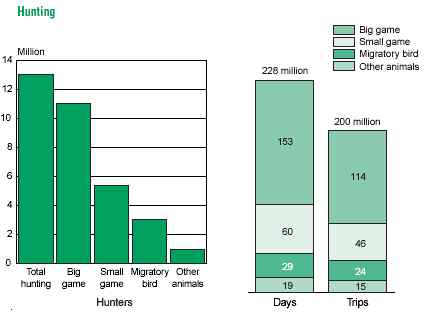
In 2001, 82 million U.S. residents, or about 39% of the population aged 16 and over participated in wildlife related recreation activities. According to a 2001 report from the U.S. Fish and Wildlife Department, this is how forty per cent Americans like to spend their outdoor time:
- 34 million fish (30%)
- 13 million hunt (12%)
- 66 million (58%) enjoy camping, wildlife watching and other related outdoor activities
These outdoor enthusiasts spent a total of $108 Billion dollars in pursuit of their wildlife related activities.
Of this amount, $21.6 billion was spent by hunters.
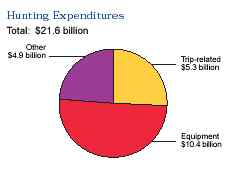
Thirteen million Americans hunted a total of 228 million days and took a total of 200 million hunting trips.
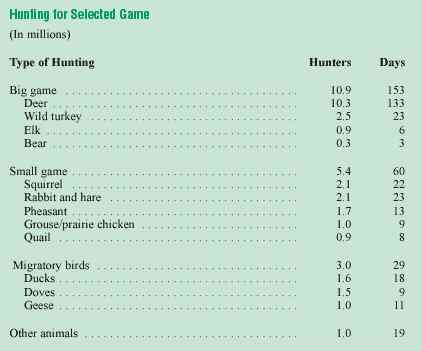
In 2001, 9 per cent of hunters were female - a sharp and significant rise from a decade ago. Last year, a substantial change took place in hunting by gender. The total number of licensed hunters fell by 2%, while the percentage of women hunters rose by 67% over the previous year. Women now represent about 15% of the hunting population.
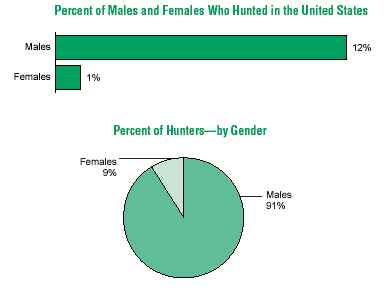
Friday, May 13, 2005
Firemen in America
Firefighters, Vet Rescue Dog Stuck in Tire
WACO, Texas: It took the Jaws of Life and a veterinarian, but Cinnamon the Boston terrier is no longer stuck in a tire.
On Tuesday, Wayne Hyde saw his 10-month-old dog's rear quarters sticking in the air, her head plugged into the center rim of a full-size tire.
Trudy Dillinger, Hyde's girlfriend, tried using Vaseline to release the 17-pound dog's head, which seemed bigger than the 4-inch-diameter ring around her neck.
Dillinger called the Bellmead Fire Department. Firefighters tried to cut the tire rim with a handheld metal saw, but they stopped to avoid accidentally hurting the dog.
Then they used their most serious extraction device, a rescue tool called the Jaws of Life, which uses hydraulic power to pry apart or slice open cars when accident victims are stuck.
The firefighters cut the center of the rim out of the tire, then took Cinnamon and her heavy metal collar to the La Vega Veterinary Clinic in nearby Waco.
"These are things you don't learn about in fire academy at all," Fire Marshall Scott Curry told the Waco Tribune-Herald for a Thursday story.
The vets used an anesthetic to relax Cinnamon's muscles and coated her neck and ears in a lubricant.
"The rim looked like it weighed more than the dog," veterinarian Tamra Walthall said. "It looked like a steel Elizabethan collar on her neck."
The dog's head eventually popped out of the ring. She was no worse for the wear, other than a little bruising and swelling around the neck, Walthall said.
Hyde, a 61-year-old plumbing and utility contractor, praised the firefighters and vowed to keep tires out of his back yard.
"There was just that one, and it's not there anymore," he said. "As a matter of fact, it's all in pieces."
Wednesday, May 11, 2005
Fox Hunting at Night With a Yaggi
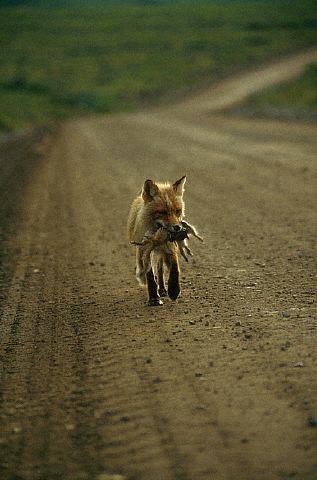 .
.The New York Times, July 28, 1981
FOXES TRACKED THROUGH THE NIGHT REVEAL A SURPRISING GROUP LIFE
By LOIS WINGERSON
_______
OXFORD, England: IT is nearly midnight and David Macdonald is out in Wytham Woods, as usual, fox hunting. He waits in his little blue van, one hand out the window aiming the antenna mounted on the roof. With the other, he adjusts the knobs of a radio receiver in his lap.
''There she is,'' he says suddenly as a series of intermittent tweets emerges from the hiss of the receiver. ''That's Old Mahogany, right where she should be, on the edge of that wood.'' Because the signal is unsteady and changes pitch, he can tell that the vixen is moving. He marks her position on a map, then drives on.
Mr. Macdonald spends nearly every night alone in this wood, keeping track of eight foxes that he captured here, fitted with radio transmitters set into collars and released. Each transmitter has a different frequency, so he can always tell Old Mahogany from Pintooth, and Bramble from Grizzle.
For the first time, thanks to electronic gadgetry, animal researchers are gaining the advantage over elusive, nocturnal animals such as foxes. Mr. Macdonald, a research fellow with Oxford University's Animal Behavior Research Group, is one of the first to use electronic technology to study the lives of individual foxes and their interaction with each other.
Many other studies, particularly in predator control, have concentrated on the movements of large populations of foxes. But Mr. Macdonald's more intimate findings are helping to rewrite the social history of the red fox, the most widely prevalent carnivore on the earth.
''There is a British and American folklore that says foxes are sly, solitary creatures that hunt alone and do not live in groups,'' Mr. Macdonald says. But years of tracking foxes and watching them with night-vision devices have helped him prove what he suspected all along: Given the opportunity, red foxes are gregarious animals that prefer to live in groups.
But they live in a surprising variety of social arrangements. In some places, such as the United States, foxes seem to live in monogamous pairs, according to most studies. There are also loners that fit the popular concept, traveling scores of miles in a night and trespassing on the territories of other foxes.
Stability of Fox Communities
But from the Arctic Circle to the deserts of Arabia, and from British farmland to dense city neighborhoods, Mr. Macdonald has also found foxes living in stable groups that have a hierarchy of their own. Some even cooperate in raising young and catching prey.
The diversity of fox societies, Mr. Macdonald believes, is directly related to the fact that foxes occupy a wide variety of habitats around the world. A better understanding of this diversity, he thinks, could lead to much better control of rabies because in many areas, particularly Europe and some parts of North America, the red fox is one of the most prevalent carriers of the disease. Mr. Macdonald is chairman of a World Health Organization committee on foxes and rabies.
''His research is very important to understanding the epidemiology of rabies and our ability to control it,'' says Dr. William G. Winkler, an epidemiologist with the national Centers for Disease Control in Atlanta. ''It is particularly important to our efforts to develop an oral vaccine against rabies, an effort which is very active in the United States.''
(Experts say that a successful effort to vaccinate foxes against rabies would be much more effective than killing the infected ones because the strategy should make entire fox communities immune.)
Rabies Eradicated in Britain
Mr. Macdonald has one great advantage over fox researchers in other areas: rabies has been eradicated in the British Isles. Thus he can laugh when recalling the time he tumbled down a hillside, embracing a wild fox he wanted to tag. Mr. Macdonald might well need to worry about being bitten but never about catching the disease he hopes to help eradicate in other countries.
At the age of 5, he wrote a school report detailing how to track red foxes across sand traps on golf courses. And for all the electronics, much of his work still involves the skills of the natural scientist.
''If anything has revolutionized the field of biology, it has been radio tracking,'' Mr. Macdonald says. ''But all the gadgetry in the world will not help if you don't pay attention to the wind direction and whether the ground is moist enough to bring out the worms the foxes eat.''
To some extent, the hours spent fox-watching only provide the questions that need to be asked. Many of the answers have come from the small group of foxes Mr. Macdonald has raised in a large enclosure. They have helped him establish that when a fox hides or caches his prey, it is able to remember and retrieve the food, and that one fox is unlikely to find another's cache by accident. The captive foxes have also helped him define the hierarchies in fox families.
Captured Foxes Provide Answers
By studying two groups of captive foxes, Mr. Macdonald was able to verify that a dominant male generally ignores all but one vixen in his group. But the nonbreeding females provide food, grooming and protection for any cubs that are born.
This year Mr. Macdonald has been concentrating on several groups of foxes living in the rural environs of Wytham Wood, a few miles outside of Oxford. He and his team have spent most of the year observing at night the eight foxes he tagged and named in the area. Each member of the team, working alone, tracks several groups of foxes at once. By their nature, the experiments take years to complete.
Often what Mr. Macdonald does is a matter of just sitting: sitting in his van or driving about the rutted lanes of the wood, his ear cocked to pick out the ghostly bleeps that represent foxes from static and car noise. The signals often bounce off trees and fences to give a completely false impression, and he may need to take readings from several different locations to make sense of the signals.
On other nights, Mr. Macdonald may sit for hours downwind of a spot that he knows is frequented by foxes, peering through either infrared binoculars or an image intensifier, a device that amplifies dim light, and simply waiting for foxes to come around. The yield is low: He only sees foxes about one of every three times, and then for only about 5 percent of the time he spends waiting. But he says the result is worth months of radio tracking since he may have the chance to see foxes courting or fighting.
'A Whole Different World'
The object of this year's effort is to compare the foxes living in Wytham Woods with the urban foxes living a few miles away near Botley Road, a wide suburban street of two-family houses and small stores. ''When you move from this area to that,'' Mr. Macdonald says, ''it's a whole different world from the fox point of view -different-sized territories, different food, different group sizes.''
Great Britain is covered with such different fox worlds, territories clearly defined and jealously guarded. Though several fox groups may occupy the same home range - the same farmland area or the same suburb -and invade each other's territory every night, Mr. Macdonald has found that the home ranges themselves never overlap. A city fox is not a country fox; and almost every aspect of their society is different.
Territory size has been found to range from about 20 acres to several thousand. The smallest territories occur in the suburbs, and the largest ones on places like the moors of Cumbria. The number of animals per territory also varies widely, from two to three in the suburbs to five or six on agricultural land.
But under normal circumstances, what makes the difference? Mr. Macdonald thinks the answer is in the abundance and distribution of food.
Food a Factor in Behavior
In the suburbs, for instance, where different people put out bird seed and the rubbish on different nights, a pair of foxes may need an entire block to be sure of ample food, and may have to live in pairs because the food supply is not abundant. In agricultural areas, on the other hand, the supply of food and prey may be so reliable that a dominant male can afford to support several ''servant'' vixens as well as his mate.
By watching enough foxes in different home ranges for enough time, Mr. Macdonald hopes, scientists may eventually learn enough to predict what kinds of groups foxes are living in by simply using a description of their habitat.
It seems a peculiar, solitary sort of science, this matter of sitting about in meadows, listening to bleeps that represent unseen foxes. Despite the electronic sophistication of radio tracking, he says, study methods are still inadequate. ''The biggest problem with his kind of experiment,'' he says, ''is that it is labor-intensive. It could take one biologist all his time to track one fox, and we simply don't have enough biologists for that.''
Tuesday, May 10, 2005
Madness With Dogs
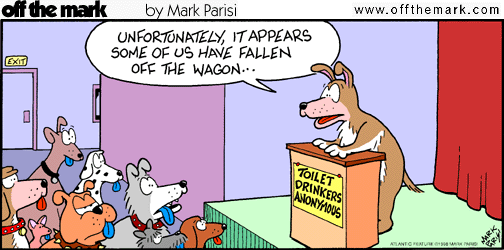
Dogs are maddening.
If our friends pissed and crapped in the house, yelled early in the morning, stole our food, humped our leg, ate their own vomit and crap, sniffed butts and then tried to kiss us we would brick them in the head in short order.
But when it's the dogs we pay good money, take good care of them, and chose our houses to suit their needs.
If this is not the definition of madness, I don't know what it.
If the big drug companies would make a pill to cure this, you know our spouses would buy it in bulk!
Monday, May 9, 2005
Winter Sign
The top picture shows a den hole above a slough on one of the farms I hunt, the next picture is a fox print in the mud of the slough, and at bottom the carcass of a deer predated upon just one field over.
This is classic fox sign, but it's one thing to find sign and another to find the fox at home!
Sunday, May 8, 2005
Upsetting the Terrier
"Things that upset a terrier may pass virtually unnoticed by a Great Dane." -- Smiley Blanton
Spin Dry That Border
Is that the fire brigade? My dog's under the washer
Barney the curious pup had his owners in a spin on Sunday when he got his head trapped under their washing machine.
The seven-week-old border terrier was trapped by the neck after putting his head in a hole where a panel was missing. His yelps alerted owners Peter Clabby and Julie Robinson, who called the fire brigade when efforts to free him failed.
Julie, 27, said: "I did think he would die. A dog's heart is quite high up in their body and we didn't want to pull him out in case we broke his neck.
"We didn't know what else to do so I rang the fire brigade and asked if it would be appropriate for them to come out."
At one point nine firefighters were squeezed into Julie's kitchen in Sunderland. Three lifted the washing machine, one held Barney and another used a hacksaw to make the hole bigger.
Miss Robinson said: "When he came out he was screaming he was so frightened, but within 10 minutes he was running around and happy again."
She added: "The firefighters were absolutely fantastic. I can't praise them enough." The couple have two children, Ethan, five, and Lewis, three.
Saturday, May 7, 2005
Hair of the Wolf that Bit 'Ya
The Associated Press and the Jackson Hole Star-Tribune of Wyoming reports that three bear hounds were killed by a wolf pack in Northern Idaho.
Sorry, but it seems to me that's the breaks when you hunt bears in the Spring when they have cubs and so too do other large animals like wolves.
The man was running bear on public land too -- while making a private profit selling these hunts to his clients. This is not "a guy" hunting his own dogs for sport, but a commercial business ($2,000 or more per day) chasing bears at a time when they should reasonably be left alone.
This wolf and hound "alteraction" occured in the Frank Church-River of No Return Wilderness which has a population of about 350 wolves.
You would think someone hunting a place called "The River of No Return Wilderness" would get the hint that there is an implied risk, and that this risk is multiplied if you are chasing bear, but you would be wrong. This smart fellow says the wolves are to blame for protecting their pups and that they should all be shot or moved .... so that he can continue to make a private profit off of public lands without any risk from wolves at all.
"If my livestock or animals get off of my property and endanger anybody, hurt anybody, or destroy any private property, I'm liable for it," Travis Reggear the owner of the hounds said. "I'd like them (state and federal officials) to be responsible for their animals' actions."
Apparently this fellow does not understand that the wolves were not off of "their" property -- they were in a Federally protected wilderness area where motorized vehicles of any kind are prohibited. And they are wild animals, not sheep dogs or hounds.
Mr. Reggear does not seem to understand that he left his house that morning with a truck load of hounds, guns and tracking equipment to chase wild and fierce animals over the American wilderness. That wilderness did not get up that morning with any intention of chasing him or his dogs around his living room. If bad things happen when people take dogs into wilderness areas, that's the breaks. The risk is assumed by the man (if not by the dogs).
As to the irony of the fact that Mr. Reggear's hounds were bit by the "hair of the dog" they were chasing -- well you know that went right over his head.
.
Wednesday, May 4, 2005
Heaven Full of Dogs
Monday, May 2, 2005
Best Import for Terrier Work
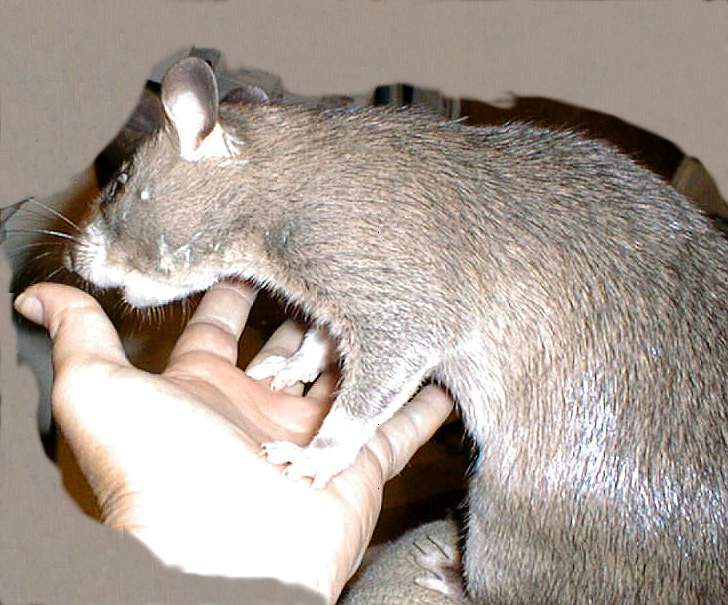
The Florida Keys, already dealing with invasive exotics from melaleuca to iguanas, have added another to the list of unwanted newcomers: the African Gambian pouch rat. The rat can grow to a weight of 3 to 8 pounds, and is now found in the wild on Grassy Key. The rats are omnivores and could end up being major predators of birds eggs, and if the rat makes it to the Everglades, there will be no stopping it.
Giant Rat Mine Detectors
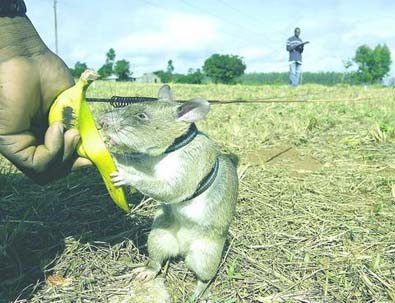
NY TIMES NEWS SERVICE , GONDOLA, MOZAMBIQUE, Wednesday, May 19, 2004
Rats Take Over From Man's Best Friend
Just about every method of detecting land mines has a drawback. Metal detectors cannot tell a mine from a tenpenny nail. Armored bulldozers work well only on level ground. Mine-sniffing dogs get bored, and if they make mistakes, they get blown up.
The Gambian giant pouched rat has a drawback, too: It has trouble getting down to work on Monday mornings. Other than that, it may be as good a mine detector as man or nature has yet devised.
Just after sunup on one dewy morning, on a football-field-sized patch of earth in the Mozambican countryside, Frank Weetjens and his squad of 16 giant pouched rats are proving it. Outfitted in tiny harnesses and hitched to 10m-long clotheslines, their long tails whipping to and fro, the rats lope up and down the lines, whiskers twitching, noses tasting the air.
Wanjiro, a sleek two-year-old female in a bright red harness, pauses halfway down the line, sniffs, turns back, then sniffs again. She gives the red clay a decisive scratch with both forepaws. Her trainer, Kassim Mgaza, snaps a metal clicker twice, and Wanjiro waddles to him for her reward -- a mouthful of banana and an affectionate pet.
A Gambian giant pouched rat searches for a landmine in a field where several defused landmines are buried at the Apopo training project in Gandola, Mozambique. The rat may be as good a mine detector as man or nature has yet devised.
"What Pavlov did with his dogs is exactly what we're doing here -- very basic conditioning," said Weetjens, a lanky, 42-year-old Belgian who works for an Antwerp demining group named Apopo. "TNT means food. TNT means clicking sound, means food. That's how we communicate with them."
Wanjiro has been rewarded for sniffing out a TNT-filled land mine, one of scores buried a centimeters below ground in the training field where she works out five days a week. Like all the training mines, this one was defused. But if the Mozambican authorities approve, she and her companions will move at year's end from dummies to live minefields -- the world's first certified, professional mine-detecting rats.
Indeed, in a test last November along a southern Mozambique railway that was heavily mined during this country's 17-year civil war, teams of three giant pouched rats found every one of 20 live mines in a previously unsurveyed 1,310m2 swatch of land.
"Animal detection, with dogs in particular, has increased very much in the last three or four years," Havard Bach, the top expert on demining methods for the Geneva International Center for Humanitarian Demining, said in a telephone interview. But in many cases, he said, "it would probably be better to use rats than dogs."
Rats are abundant, cheap and easily transported. At 1.3kg, they are too light to detonate mines accidentally. They can sift the bouquet of land-mine aromas far better than any machine. Unlike even the best mine-detecting dog or human, they are relentlessly single-minded.
"Throw a stick for a dog to fetch, and after 10 times the dog will say, `Get it yourself, buddy,"' Weetjens said. "Rats will keep working as long as they want food."
Plenty of work awaits them. The International Campaign to Ban Land Mines estimates that 100 million mines have been laid worldwide, from anti-personnel and anti-tank mines hidden underground to above-ground mines triggered by tripwires. Although Mozambique's civil war ended nearly 12 years ago, sappers here still discovered and destroyed more than 10,100 mines last year alone, and mine explosions killed or injured 14 people.
Experts say that the pace of land-mine detection has slowed globally in recent years, in part because the death of its celebrity spokeswoman, Princess Diana, has robbed the cause of publicity and support. But there is also a shortage of land-mine specialists, and a true dearth of sure-fire methods to find buried mines.
Human detection -- steel-nerved workers with metal detectors and probes -- remains the preferred technique. But metal detectors are hard put to distinguish mines from other metal objects and even from some nonmetals, like mixtures of dirt and charcoal. Moreover, in areas where exploded mines have scattered metal fragments, rooting out false readings can be daunting.
Dogs, with their strong noses and affinity for people, are increasingly popular; about 200 are working now in heavily mined Afghanistan. But they are hard to keep healthy, especially in tropical Africa. They tend to bond with trainers, making it hard to switch them from one handler to another.
And they so badly want to please that a simple misreading of their trainers' body language can lead them to indicate a mine's presence where none exists or, far worse, ignore a real one.
Then there are rats, which don't give a fig about people but will do anything for bananas and peanuts. "All a rat wants to do is find the target and get his reward," said Bach, of the Geneva demining center. "They're almost mechanical in the way they work."
Mine-sniffing rats are the sole focus of Apopo, a Flemish acronym for "product development geared toward the demining of anti-personnel mines." The group is the brainchild of Weetjens' brother Bart, a college friend, Christophe Cox, and a University of Antwerp professor, Mic Billet, now Apopo's chairman.
The three decided in the late 1990s that so-called biosensor animals with great noses were the future of land-mine detection, but that there must be creatures better suited for the task than dogs.
With a grant from the Belgian government, they began hunting for an animal with a dog's sense of smell, but none of its drawbacks. They approached Ron Verhagen, the head of the university's biology department, for help. "And that," Weetjens said, "is where rats came along."
More specifically, along came Cricetomys gambianus, also known as the Gambian and African giant pouched rat. Up to 76cm-long, it thrives in most of sub-Saharan Africa, lives up to eight years in captivity and is "savage" in the wild, Weetjens says, but so docile when bred that some people keep them as pets.
Most important, the pouched rat (so named because it stores food, hamster-style, in its cheeks) buries what it does not immediately eat and sports a nose honed to bloodhound status by aeons of searching for buried food stashes. Persuading the giant pouched rat to hunt for land mines, therefore, is as simple as convincing him that TNT is just another tasty treat waiting a few inches underground.
Each rat gets to sweep a 10m2 of land on which two defused mines or TNT scents have been hidden. Finding the mine or scent earns a click and a bite of banana or peanuts. Failure generally earns a second try. Some rats try to game the system, scratching the earth randomly in hopes of getting free treats. But the trainers feed them and sound a click to signal success only when they scratch the right spots.
Bananas and peanuts, after all, are what drives Gambian giant pouched rats to excel. Which is why they are often at their worst on Monday morning.
"During the week, they're on a diet. They have to work for their food," Weetjens said. "But on weekends, they get to eat as much as they want. On Mondays, they just aren't as hungry."
This story has been viewed 1197 times.
Sunday, May 1, 2005
Maggie Makes It: The 6-Inch Tunnel Test
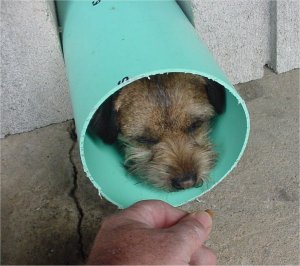
Bill Kasting read the April 20th "Daily Dose" and decided to see if his border terrier Maggie could make it through a 6-inch pipe. We are happy to report that the answer is a decided "YES," and Bill has the pictures to prove it. Check out more pictures and text at http://border.kastingauction.com/sixinch.html
Congratulations to Maggie!
Bill reports that he and Maggie will be hitting the fields in Missouri later this month -- Excellent!
